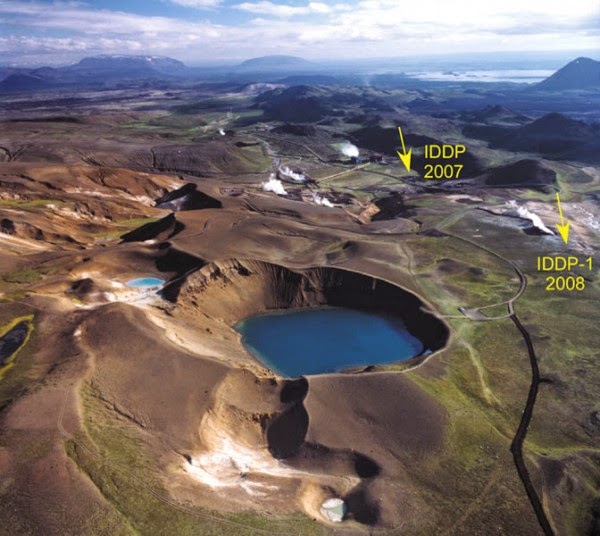
Still searing from the formation of the solar system, the core of Earth is a nuclear reactor generating heat from the breakdown of radioactive elements like uranium, thorium, and potassium. Scientists have been harnessing that heat for decades by drilling deep wells to power turbines. But now researchers have been able to tap into even greater energy by drilling into volcanoes and exploiting the heat of molten rock. If current geothermal wells are replaced with the new technology, it could provide 30% more power than current renewable energy sources.
The idea of tapping the energy of magma came from a pair of accidents. In 1985, workers drilling for a geothermal well in Iceland ran into a sudden and uncontrollable blast of high-pressure steam. Scientists think the steam originated from a reservoir of water that’s under such pressure that as it begins to boil, the water cannot expand enough to become vapor and remains in a liquidlike state. Water in such a “supercritical state” contains enormous amounts of energy. Water reaches this state once it reaches 222 bars of pressure and 374°C or above, and flashes into steam when the pressure drops as the water rises to the surface.
For the next 2 decades, researchers dreamed of capturing superhot steam from supercritical fluids and turning it into electricity. Whereas a typical geothermal well produces 5 to 10 MW of electricity, geologist Wilfred Elders, an emeritus professor at the University of California, Riverside, says supercritical wells could potentially yield 10 times that much.
The second unexpected event happened in 2009. The Icelandic Deep Drilling Project (IDDP), a consortium of energy companies and scientists, including Elders, had begun drilling for the theorized supercritical fluid wells when they hit a pocket of magma. The molten rock ruined their equipment, but the team realized that the intense heat could actually boost the production capability of the well. The higher the temperature, the easier it becomes for water to enter a supercritical state, and the magma pouring into their well was hotter than 900°C. “There is an enormous energy potential, orders of magnitude greater than can be produced from conventional geothermal systems at 200 to 300°C,” Elders says.
To use the magma for energy, workers wouldn’t drill directly into it. Instead, they could either tap into superhot water in nearby magma-heated rock and use its steam to turn turbines, or make artificial steam by injecting water from the surface. In 2011, the researchers finished the well just above the magma, where the temperature didn’t quite reach 900°C. Even so, the well generated superheated steam and 35 MW of electricity at 500°C, Elders and his colleagues report in the current issue of Geothermics. For the first time, researchers proved it was possible to create supercritical geothermal wells enhanced by magma.
It isn’t so simple though. IDDP’s 2011 well suffered from mechanical failure after only 2 years of use, and tools are still being developed to withstand such extreme conditions. Location is a problem, too: Magma-heated systems require active volcanoes, and even there it’s exceedingly hard to find magma to drill into. It’s “a bit like finding a needle in a haystack,” says Bruce Marsh, a professor at Johns Hopkins University’s Department of Earth and Planetary Sciences, who wasn’t involved in the work. These types of wells won’t be easily replicable, but Marsh is hopeful. “Maybe after we find a few of these things, we’ll know how to look for them,” he says.
Power aside, Marsh says he is excited about the wells’ scientific value. Magma is hard to study, he notes. Researchers usually analyze it as solid rock that has come to the surface or as solid drill cores. But now scientists might be able to study it from where it is inside the crust and begin understanding what drives systems in Earth’s interior. “We’ve got a tiger by the tail,” Marsh says. “It’s the difference between studying something in the zoo and studying it in the wild.”
IDDP, meanwhile, is moving forward with other supercritical geothermal wells in Iceland soon, and similar projects are under way in New Zealand and Japan. “There’s enormous potential out there,” Marsh says.
Note : The above story is based on materials provided by Angus Chen ” American Association for the Advancement of Science. “










